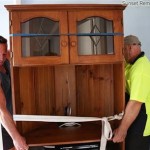Hump Straps: A Comprehensive Guide to Furniture Moving Straps
Moving furniture is a challenging and potentially hazardous task. Improper lifting techniques can lead to back injuries, strains, and other musculoskeletal problems. Traditional methods often rely on brute strength and awkward maneuvering, increasing the risk of damage to both the furniture and the surrounding environment. Hump straps, also known as furniture moving straps or shoulder dolly straps, offer a safer and more efficient alternative. These straps distribute the weight of the object across the mover’s body, allowing for better balance, control, and reduced strain.
This article provides a comprehensive overview of hump straps, covering their functionality, benefits, proper usage, types, and what to consider when selecting a set. The goal is to offer individuals and professional movers a thorough understanding of how hump straps can enhance the furniture moving process.
How Hump Straps Function
Hump straps operate on the principle of weight distribution and leverage. A typical set consists of two adjustable straps, each worn over the shoulders. These straps are designed to connect to a central strap or harness that cradles the furniture or object being moved. The weight of the object is then transferred from the mover's hands and arms to their stronger core muscles and legs.
The adjustable nature of the straps allows for customization based on the height and build of the movers. This ensures a comfortable and secure fit, maximizing weight distribution and minimizing the risk of strain. The central strap or harness provides a stable base for the furniture, preventing it from shifting or tilting during transport. Furthermore, the design facilitates synchronized movement between two movers, promoting teamwork and coordination.
By lifting with the legs and maintaining an upright posture, the use of hump straps reduces the load on the lower back, significantly decreasing the risk of back injuries. The enhanced control also minimizes the chances of accidental drops or collisions with walls and doorways, protecting both the furniture and the surrounding environment.
Benefits of Using Hump Straps
The advantages of using hump straps extend beyond simply reducing the risk of injury. These straps offer a range of benefits that contribute to a more efficient and safer moving experience.
Reduced Risk of Injury: As previously discussed, hump straps distribute weight more evenly across the body, shifting the load from the arms and back to the legs and core. This significantly minimizes the risk of back strain, muscle pulls, and other common moving-related injuries. This is especially crucial for individuals with pre-existing back problems or those who regularly engage in heavy lifting.
Increased Lifting Capacity: By utilizing the stronger muscles of the legs and core, movers can safely lift and transport heavier objects than they could manage using traditional methods. This is particularly useful for moving large appliances, heavy furniture pieces, and other bulky items that would otherwise require specialized equipment or a larger team.
Improved Balance and Control: The straps provide a secure and stable connection between the movers and the object being moved. This enhanced control reduces the risk of wobbling, tilting, or dropping the furniture, especially when navigating stairs, tight corners, or uneven surfaces. The improved balance also minimizes the risk of slips and falls for the movers themselves.
Enhanced Efficiency: Hump straps can streamline the moving process by allowing for faster and more coordinated movements. The improved weight distribution and control enable movers to navigate obstacles more easily and efficiently. This can result in significant time savings, especially when moving large or numerous items.
Protection of Furniture and Surroundings: The reduced risk of dropping and the enhanced control offered by hump straps minimize the chances of damage to the furniture being moved. They also reduce the likelihood of accidental collisions with walls, doorways, and other objects in the environment, preventing scratches, dents, and other forms of damage.
Two-Person Advantage: The design of hump straps naturally encourages teamwork and coordination between two movers. The shared weight distribution and synchronized movements promote a collaborative approach, making the moving process smoother and more efficient. This is particularly beneficial for moving large and bulky objects that require two people to handle safely.
Proper Usage of Hump Straps
While hump straps offer numerous benefits, their effectiveness depends on proper usage. Incorrectly using the straps can negate their advantages and potentially increase the risk of injury. The following steps outline the correct procedure for using hump straps.
Preparation and Adjustment: Before lifting any object, both movers should put on their respective shoulder straps and adjust them to a comfortable and secure fit. The straps should be snug but not overly tight, allowing for a full range of motion. The central strap or harness should be positioned correctly to support the furniture evenly. Ensure both movers understand the plan and direction of movement.
Proper Lifting Technique: Emphasize lifting with the legs, keeping the back straight, and engaging the core muscles. Avoid bending at the waist or twisting the body, as this can put excessive strain on the back. Maintain a wide stance for stability and keep the furniture close to the body.
Synchronized Movement: Communication is key when using hump straps. Both movers should communicate clearly and coordinate their movements to avoid sudden jerks or shifts in weight. Maintain a consistent pace and avoid pulling or pushing against each other. On stairs, one mover should lead, and the other should follow, communicating each step clearly.
Navigating Obstacles: Maneuvering around tight corners or obstacles requires careful planning and coordination. Communicate the intended path and adjust the grip on the furniture as needed. Take small, controlled steps and avoid rushing. If necessary, pause and reassess the situation before proceeding.
Lowering the Furniture: Lowering the furniture should be done in a controlled and coordinated manner, following the same principles as lifting. Bend at the knees, keeping the back straight, and gradually lower the object to the ground. Avoid dropping the furniture or letting it slide, as this can cause damage.
Safety Precautions: Wear appropriate safety gear, including closed-toe shoes and gloves, to protect your feet and hands. Clear the path of any obstacles or hazards before moving the furniture. Be aware of your surroundings and avoid distractions. If you're unsure about the safety of a particular maneuver, stop and seek assistance.
Types of Hump Straps
Several types of hump straps are available, each with its own design features and intended use. Understanding the different types can help you choose the best option for your specific needs.
Traditional Shoulder Dolly Straps: These are the most common type of hump straps, consisting of two adjustable shoulder straps connected to a central strap or harness. They are suitable for moving a wide range of furniture items and appliances. The length of the straps is adjustable, allowing for customization based on the size of the object and the height of the movers. The shoulder pads are typically padded for comfort and to prevent chafing.
Forearm Forklifts: While not strictly hump straps, forearm forklifts offer a similar weight distribution principle. They consist of two adjustable straps worn around the forearms, allowing movers to lift and carry objects from underneath. These straps are particularly useful for moving boxes, mattresses, and other relatively lightweight items. They are less suitable for moving heavy furniture pieces that require more stability and control.
Appliance Rollers with Straps: These devices combine the benefits of appliance rollers with the weight distribution of straps. The rollers are placed under the appliance, allowing it to be easily moved across smooth surfaces. The straps are then used to secure the appliance to the rollers and provide additional stability and control. These devices are ideal for moving refrigerators, washing machines, and other large appliances.
Specialized Straps for Specific Items: Some manufacturers offer specialized straps designed for moving specific items, such as pianos, safes, or gun safes. These straps typically feature reinforced construction and specialized attachments to ensure a secure and stable grip on the object. They may also include additional padding or protection to prevent damage to the item being moved.
Factors to Consider When Selecting Hump Straps
Choosing the right set of hump straps is crucial for ensuring a safe and efficient moving experience. Several factors should be considered when making a selection.
Weight Capacity: The most important factor is the weight capacity of the straps. Ensure that the straps are rated to handle the weight of the heaviest item you plan to move. Exceeding the weight capacity can lead to strap failure and potentially cause serious injury.
Adjustability: The straps should be easily adjustable to accommodate different heights and body sizes. This ensures a comfortable and secure fit for both movers. Look for straps with a wide range of adjustability and easy-to-use buckles or clasps.
Material and Construction: The straps should be made from durable and high-quality materials that can withstand the rigors of moving. Look for straps made from heavy-duty nylon or polyester webbing with reinforced stitching. The buckles and clasps should be made from sturdy metal that won't break or bend under pressure.
Comfort: The shoulder pads should be adequately padded to prevent chafing and discomfort. Consider straps with breathable materials to minimize sweating and overheating. The overall design of the straps should be ergonomic and comfortable to wear for extended periods.
Ease of Use: The straps should be easy to put on, adjust, and use. Look for straps with clear instructions and intuitive designs. Avoid straps with complicated buckles or attachments that can be difficult to operate.
Price: Hump straps are available at a range of price points. While it's important to stay within your budget, don't compromise on quality or safety. Invest in a set of straps that are durable, reliable, and comfortable to use.
Reviews and Ratings: Before purchasing any hump straps, read online reviews and ratings from other users. This can provide valuable insights into the quality, durability, and performance of the straps. Pay attention to both positive and negative reviews and consider the overall consensus before making a decision.
By considering these factors, individuals and professional movers can select the right set of hump straps to enhance their furniture moving endeavors, prioritizing safety, efficiency, and protection of both the furniture and the individuals involved.

How To Use A Humpstrap When Moving

How To Use A Humpstrap When Moving

How To Use A Humpstrap When Moving

Forearm Forklift Lifting Straps Furniture Moving

How To Use A Humpstrap When Moving

Us Cargo Control Forearm Forklift Moving Straps

How To Use A Humpstrap When Moving

Mastering Box Carrying How To Use A Hump Strap Professional Movers Guide Using

Hump Strap Heavy Duty 4 Ply Burlap Lifting X 15

Burlap Carrying Strap 4 Wide X 15








